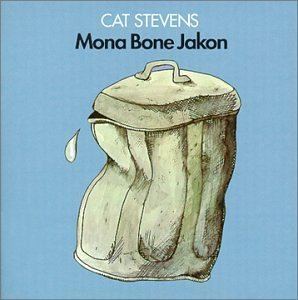Released 24 April 1970 | Length 35:15 Release date 24 April 1970 Label A&M Records | |
 | ||
Similar Cat Stevens albums, Folk rock albums | ||
Mona bone jakon cat stevens
Mona Bone Jakon is the third studio album released by singer-songwriter Cat Stevens, released in April 1970 on the Island Records label in the United Kingdom and on the A&M record label in the United States and Canada.
Contents
- Mona bone jakon cat stevens
- Background
- Origin of title
- Critical reception
- Track listing
- Personnel
- Production
- Charts
- Songs
- References
After a meteoric start to his career, surprising even his original producer at Deram Records with the hit singles "I Love My Dog", "Matthew and Son", and "I'm Gonna Get Me a Gun", Stevens' debut album, Matthew and Son began charting as well. However, after the pressure for a repeat album of the same calibre, Stevens, considered a young teen sensation, was overwhelmed by a new lifestyle, as well as the demands of writing, recording, performing, publicity appearances, and touring. His second album was a commercial failure and in the fall of 1968, he collapsed, with the diagnosis of tuberculosis and a collapsed lung. For over a year, while recovering, Stevens virtually disappeared from the British pop scene. Mona Bone Jakon is notable not only for his return, but for the emergence of a very different artist. The album was certified gold for sales/shipments of more than 500,000 copies in the United States.
Background
During his hospital-dictated year of bedrest, he began writing a catalogue of songs to fill far more than his next album. After his recovery, Stevens negotiated out of his contract with Deram Records and joined with former Yardbirds bassist Paul Samwell-Smith with a stripped down sound, with songs played in spare arrangements on acoustic guitars and keyboards and accompanied by a sparse backing band, consisting only of three other performers: second guitarist Alun Davies, bassist John Ryan, and drummer Harvey Burns—and on one song, "Katmandu", Peter Gabriel on the flute. Smith also produced the album and brought Stevens a high fidelity sound that was not as present on his previous releases. Samwell-Smith was one of the early producers in rock to push the lower bass frequencies more prominently into the mix in an attempt to keep up with the new audiophile generation which was embracing larger home speakers and high end phonographic cartridges. Stevens began to make the transition from pop star to a folk-rock performer, when the term "singer-songwriter" was just being coined.
The songs themselves were darker in tone: the madrigal-inspired ballad "Lady D'Arbanville" elevated the tragedy of a lost lover (in this case, Stevens' former girlfriend Patti D'Arbanville) to that of a deceased one; "Trouble" was a plea to stave off death. There were also lighter songs; "Pop Star" showcased Stevens' dramatic change in voice by satirising the triviality of celebrity.
Though "Lady D'Arbanville" would reach No. 8 on the British charts, Mona Bone Jakon was only a modest success upon its initial release. The album attracted attention, however, in the wake of the commercial breakthrough of its follow-up, Tea for the Tillerman, and with the inclusion of three of its songs ("Trouble", "I Wish, I Wish", and "I Think I See the Light") in Hal Ashby and Colin Higgins's black comedy Harold and Maude in 1971.
Origin of title
According to a 1972 interview with Stevens, the inspiration for the title was a name he created to describe his penis: "'Mona Bone Jakon' is another name for my 'penis'. It's the name I give it. It's not some sort of secret vocabulary, it's just something I made up."
Journalist Robert Chalmers reiterated this point for a 2003 interview with Islam for The Independent on Sunday when he wrote: "When [Stevens] re-emerged in 1969, he had more than 40 new songs and released three triumphant albums in 15 months on Chris Blackwell's Island label: Mona Bone Jakon (his pet word for penis), Tea For The Tillerman and Teaser And The Firecat."
Critical reception
In a contemporary review for The Village Voice, music critic Robert Christgau gave Mona Bone Jakon a "B+" and said that after the commercial failure of New Masters, "this one has a nice post-creative trauma feel, intimate and sensitive. Recommended to singer/songwriter specialists." In a retrospective review, Allmusic's William Ruhlmann gave it four out of five stars and called it "a group of simple, heartfelt songs played in spare arrangements on acoustic guitars and keyboards and driven by a restrained rhythm section." They added that "Stevens' craggy voice, with its odd breaks of tone and occasional huskiness, lent these sometimes sketchy songs depth".
Track listing
All tracks written by Cat Stevens.
Personnel
Production
Charts
Album
Singles
Songs
1Lady D'Arbanville3:44
2Maybe You're Right3:26
3Pop Star4:14
